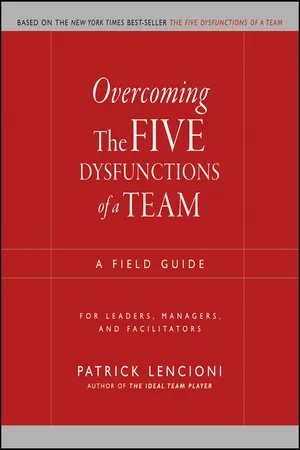
Overcoming the Five Dysfunctions of a Team
A Field Guide for Leaders, Managers, and Facilitators
- English
- ePUB (mobile friendly)
- Available on iOS & Android
Overcoming the Five Dysfunctions of a Team
A Field Guide for Leaders, Managers, and Facilitators
About this book
Practical exercises and hands-on tools to bring to life the timeless advice found in the author's best-selling book, The Five Dysfunctions of a Team
In the years following the publication of Patrick Lencioni's best seller, The Five Dysfunctions of a Team, fans have been clamoring for more information on how to implement the ideas outlined in the book.
In Overcoming the Five Dysfunctions of a Team, Lencioni offers specific, practical guidance for overcoming the five dysfunctions, using tools, exercises, assessments, and real-world examples. He examines questions that all teams must ask themselves: Are we really a team? How are we currently performing? Are we prepared to invest the time and energy required to be a great team?
Written concisely and to the point, this guide gives leaders, line managers, and consultants alike the tools they need to get their teams up and running quickly and effectively.
Frequently asked questions
- Essential is ideal for learners and professionals who enjoy exploring a wide range of subjects. Access the Essential Library with 800,000+ trusted titles and best-sellers across business, personal growth, and the humanities. Includes unlimited reading time and Standard Read Aloud voice.
- Complete: Perfect for advanced learners and researchers needing full, unrestricted access. Unlock 1.4M+ books across hundreds of subjects, including academic and specialized titles. The Complete Plan also includes advanced features like Premium Read Aloud and Research Assistant.
Please note we cannot support devices running on iOS 13 and Android 7 or earlier. Learn more about using the app.
Information
SECTION TWO
Overcoming the Five Dysfunctions of a Team

OVERCOMING DYSFUNCTION #1
BUILDING TRUST
Defining Trust
The Invulnerable Leader Story
I once worked with a large company—one that, if you haven’t used their products, you’ve certainly heard of—that demonstrated how a lack of trust can destroy years of hard work and accomplishment. Let’s call the company Passivity.Passivity had been a highly respected and accomplished company over the years, but had recently fallen on hard times at the hands of a larger, more aggressive competitor. Still, the company had legions of dedicated customers and employees, if not Wall Street analysts.Enter the new CEO of Passivity, a man who neither valued nor elicited trust among his executive team. As the company, under the guidance of its new leader, watched its demise accelerate, journalists and industry-watchers attributed the spiral to unwise decisions about products and strategy. And while those decisions certainly contributed to the problem, they were merely symptoms of a bigger issue.That issue could only be observed behind the scenes, at executive staff meetings. It was there that a tornado of distrust was raging, leaving in its wake a sea of bad decisions and real human suffering. Not to mention drowning stock options.As is often the case, the trust vacuum emanated from the leader, a brilliant man whose intelligence was rivaled only by his inability to acknowledge his own limitations. This was made apparent to me, and the rest of his team, on many occasions, but none more painfully so than when he reluctantly “shared” the results of his 360-degree feedback during a staff meeting.Standing before his team with his 360-degree report in his hands, the leader of Passivity started by addressing his weaknesses. “It says here that I’m not a good listener,” he announced, with a puzzled look on his face. “Hmm. What do you guys think?” After a brief and awkward moment of silence, the executives around the table assured their boss that he was not a bad listener at all, and that he was indeed better than many of the other leaders they had known. He accepted their reassurance without a fight.“Okay. What about this next one? It says I don’t give enough praise.” Again, one by one the team shrugged and nodded their assurance that this was not really a problem.It was at that moment that I kindly reminded the team that they were, in fact, the only people who had completed the 360-degree survey, and that someone had to have given the CEO low scores in these areas. After an awkward pause, a lone brave soul raised his hand. “Okay, I’ll admit it. I think you could give a little more positive feedback,” he offered almost apologetically. “I mean, my people don’t usually hear anything from you unless they’ve screwed up. It would be nice if we, or they, knew what they were doing well.”After yet another awkward moment, one of the other executives in the room declared, in the direction of the CEO, “I don’t see it. I think you give more praise than most CEOs I know.” This set off a wave of head nodding, leaving the lone brave soul out in the cold, wondering why he’d bothered telling the truth.
The Difficulty of Vulnerability-Based Trust
Table of contents
- Cover
- Table of Contents
- Title
- Copyright
- Dedication
- WHY A FIELD GUIDE?
- SECTION ONE: Getting Clear on the Concept
- SECTION TWO: Overcoming the Five Dysfunctions of a Team
- SECTION THREE: Answering Questions and Anticipating Problems
- SECTION FOUR: Building the Team
- GLOSSARY OF TERMS
- RESOURCES
- ACKNOWLEDGMENTS
- ABOUT THE AUTHOR
- Advertisement
- End User License Agreement